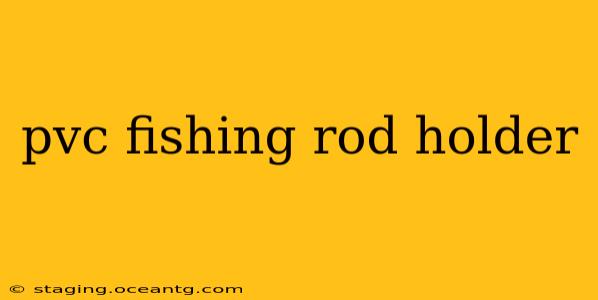Fishing enthusiasts know the importance of properly storing their rods to prevent damage and maintain their integrity. A well-organized rod storage system not only protects your valuable fishing equipment but also enhances your overall fishing experience. PVC pipe offers a surprisingly versatile and cost-effective solution for creating durable and customizable fishing rod holders. This guide will walk you through the process of building your own PVC fishing rod holders, addressing common questions and concerns.
Why Choose PVC for Fishing Rod Holders?
PVC pipe is an ideal material for building fishing rod holders due to its several advantages:
- Durability: PVC is resistant to water damage, rot, and UV degradation, ensuring your rod holders will last for years.
- Cost-effectiveness: PVC pipe is relatively inexpensive and readily available at most hardware stores.
- Customizability: You can easily cut and adapt PVC pipe to fit your specific needs and storage space.
- Lightweight: PVC is lightweight, making it easy to transport and install your rod holders.
- Easy to Work With: PVC requires minimal tools and skills to cut, shape, and assemble.
What are the Different Types of PVC Fishing Rod Holders?
Several designs cater to various needs and preferences:
- Wall-mounted holders: These are ideal for garages, sheds, or boat interiors, keeping rods securely stored and out of the way.
- Rack-style holders: These stand-alone units offer multiple rod slots, allowing you to store a collection of fishing rods in one organized location.
- Boat-mounted holders: Designed for boat storage, these holders securely hold your rods during transport and storage. These are often more robust and weather-resistant.
- Portable holders: Smaller, more compact holders designed for easy transport to and from fishing locations.
How Do I Build a Simple PVC Fishing Rod Holder?
Building a basic PVC rod holder is a straightforward process:
- Gather materials: You'll need PVC pipe (diameter depends on your rod size), PVC connectors (elbows, tees, and caps), PVC cement, a saw (hacksaw or PVC cutter), and sandpaper.
- Cut the pipe: Measure and cut the PVC pipe to your desired lengths. Ensure the lengths are appropriate for your rods, allowing enough space for comfortable insertion and removal.
- Assemble the holder: Use PVC cement to connect the pipe sections according to your design. Allow the cement to dry completely before use.
- Sand the edges: Sand any rough edges to prevent damage to your fishing rods.
How Much Does it Cost to Make a PVC Fishing Rod Holder?
The cost varies significantly based on the design complexity and the amount of PVC materials used. A simple wall-mounted holder could cost as little as $10-$20, while a more complex rack could cost $30-$50 or more. The cost is still significantly less than purchasing a pre-made holder.
What Size PVC Pipe Should I Use for My Fishing Rod Holder?
The ideal PVC pipe diameter depends on the butt diameter of your fishing rods. Generally, a 3-inch diameter pipe is suitable for most rods. Measure the butt diameter of your rods to select the appropriate size PVC pipe that ensures a snug but not overly tight fit.
How Do I Make a PVC Fishing Rod Holder More Durable?
To enhance durability:
- Use high-quality PVC: Invest in thicker-walled PVC pipe for added strength.
- Reinforce connectors: Use additional glue or adhesive to strengthen the joints.
- Apply a protective coating: Consider painting or applying a sealant to protect the PVC from UV rays and the elements (particularly for outdoor applications).
Are PVC Fishing Rod Holders Waterproof?
PVC itself is waterproof, but the cement joints might need extra sealing if you're using your holders in extremely wet conditions. A waterproof sealant applied to the joints will ensure complete protection from water damage.
This guide provides a foundation for creating your own custom PVC fishing rod holders. Remember to tailor your design to your specific needs and storage space. With a little planning and effort, you can easily create a durable and efficient system to protect your fishing rods and keep your tackle organized.
